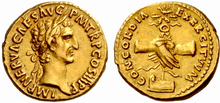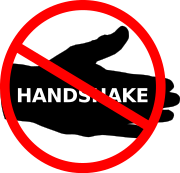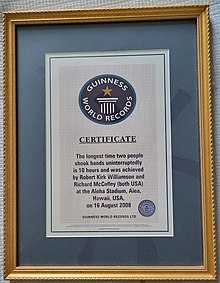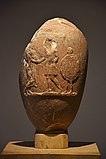

A handshake is a globally widespread, brief greeting or parting tradition in which two people grasp one of each other's hands, and in most cases, it is accompanied by a brief up-and-down movement of the grasped hands. Customs surrounding handshakes are specific to cultures. Different cultures may be more or less likely to shake hands, or there may be different customs about how or when to shake hands.
History

The handshake may have originated in prehistory as a demonstration of peaceful intent, since it shows that the hand holds no weapon. Another possibility is that it originated as a symbolic gesture of mutual commitment to an oath or promise: two hands clasping each other represents the sealing of a bond. One of the earliest known depictions of a handshake is an ancient Assyrian relief of the 9th century BC depicting the Assyrian king Shalmaneser III clasping the hand of the Babylonian king Marduk-zakir-shumi I to seal an alliance.

Archaeological ruins and ancient texts show that handshaking was practiced in ancient Greece (where it was called dexiosis) as early as the 5th century BC. For example, a depiction of two soldiers joining hands can be found on part of a 5th-century BC funerary stele that is on display in Berlin's Pergamon Museum (stele SK1708) and on other funerary steles, such as one from the 4th century BC that depicts Thraseas and his wife Euandria shaking hands.

Depictions of handshakes also appear in Archaic Greek, Etruscan and Roman funerary and non-funerary art. Muslim scholars have written that the custom of handshaking was introduced to them by the people of Yemen.
Modern customs





There are various customs surrounding handshakes, both generally and specific to certain cultures:
The handshake is commonly done upon meeting, greeting, parting, offering congratulations, expressing gratitude, or as a public sign of completing a business or diplomatic agreement. In sports, it is also done as a sign of good sportsmanship. Its purpose is to convey trust, respect, balance, and equality. If it is done to form an agreement, the agreement is not official until the hands are parted.
Unless health issues or local customs dictate otherwise, a handshake is made usually with bare hands. It depends on the situation.
By geographic location
- In Anglophone countries, handshaking is common in business situations. In casual non-business situations, men are more likely to shake hands than women.
- In the United States, United Kingdom and Canada, a traditional handshake is firm, executed with the right hand, with good posture and eye contact. A handshake where both parties are standing up is deemed as good etiquette.
- Austrians shake hands when meeting, often including with children.
- In the Netherlands and Belgium, handshakes are done more often, especially on meeting.
- In Denmark, the final step in acquiring Danish citizenship is a ceremony at which a handshake with a local official is specifically required (gloves may not be worn).
- In Norway, where a firm handshake is preferred, people most often shake hands when agreeing on deals, in private and business relations.
- In Russia, a handshake is performed between men and rarely performed by women.
- In Switzerland, it may be expected to shake the women's hands first.
- In Israel, handshakes are standard among Jews (other than ultra-religious Jews, between genders), but not among Arabs.
- In some countries such as Turkey or the Arabic-speaking Middle East, handshakes are not as firm as in the West. Consequently, a grip that is too firm is rude.
- Moroccans will give a soft handshake to someone of the same gender, along with one kiss on each cheek (lips don't touch the cheek unless they are family). The handshake may be followed by lightly touching one's heart with one's right hand.
- In Armenia, handshakes are the most common greetings between men, optionally followed by a kiss on the cheek if the two parties have a close relationship. Traditionally, a woman needs to wait for the man to present his hand for the handshake. Women usually greet each other with hugs and a kiss on the cheek.
- In China, age is considered important in handshake etiquette, and older people should be greeted with a handshake before others. A weak handshake is also preferred, but people shaking hands often hold on to each other's hands for an extended period after the initial handshake.
- In Japan, there is not a tradition of shaking hands and it is preferred to formally bow to each other (with hands open by their sides). Japanese people may greet foreigners with a handshake; foreigners are advised to let Japanese people initiate any handshakes, and a weak handshake is preferred. A curious exception are so-called handshake events.
- In Korea, a senior person will initiate a handshake, which is preferred to be weak. It is a sign of respect to grasp the right arm with the left hand when shaking hands. It is considered disrespectful to put the free hand in one's pocket while shaking hands. Bowing is the preferred and conventional way of greeting a person in Korea.
- In Thailand, handshaking is only done if the traditional wai is not offered. When a person offers a wai, placing their palms together at chest level and bowing, this is then returned, with men saying “Sawadee-krap” and women saying “Sawadee-kah” (both mean “Hello").
- In India and several nearby countries, the respectful Namaste gesture, sometimes combined with a slight bow, is traditionally used in place of handshakes. Handshakes are preferred in business and other formal settings.
- In some areas of Africa, handshakes are continually held to show that the conversation is between the two talking. If they are not shaking hands, others are permitted to enter the conversation.
- Masai men in Africa greet one another by a subtle touch of palms of their hands for a very brief moment of time.
- In Liberia, the snap handshake is customary in which the two shakers snap their fingers against each other at the conclusion of the handshake.
- In Ethiopia, it is considered rude to use the left hand during a handshake. While greeting the elderly or a person in authority, it is also customary to accompany the handshake with a bow and the left hand supporting the right.
- In Indonesia, it is considered rude to use one's left hand as it is a hand designated for unclean duties. A medium to soft handshake grip is sufficient, since gripping too hard could be considered rude or an act of aggression.
Other
- Related to a handshake but more casual, some people prefer a fist bump. Typically the fist bump is done with a clenched hand. Only the knuckles of the hand are typically touched to the knuckles of the other person's hand. Unlike the formality of a handshake, the fist bump is typically not used to seal a business deal or in formal business settings.
- The hand hug is a type of handshake popular with politicians, as it can present them as being warm, friendly, trustworthy and honest. This type of handshake involves covering the clenched hands with the remaining free hand, creating a sort of "cocoon".
- In the sport of fencing, after the Olga Kharlan handshaking incident in 2023, the International Fencing Federation changed its rules so that the previously required handshakes between fencers at the end of a bout would become optional, with a distance greeting permitted instead.
Germ spreading

Handshakes are known to spread a number of microbial pathogens. Certain diseases such as scabies are known to spread most frequently through direct skin-to-skin contact. A medical study has found that fist bumps and high fives spread fewer germs than handshakes. During the 2009 H1N1 pandemic, the dean of medicine at the University of Calgary, Tom Feasby, suggested that fist bumps may be a "nice replacement of the handshake" in an effort to prevent transmission of the virus.
Following a 2010 study that showed that only about 40% of doctors and other health care providers complied with hand hygiene rules in hospitals, Mark Sklansky, a doctor at UCLA hospital, decided to test "a handshake-free zone" as a method for limiting the spread of germs and reducing the transmission of disease. UCLA did not ban the handshakes outright, but rather suggested other options such as fist bumping, smiling, bowing, waving, and non-contact Namaste gestures. Other sources suggest raised brows, wai bow, two claps, hand over heart, sign language wave, or the shaka sign.
During the COVID-19 pandemic, several countries and organisations adopted policies encouraging people to use alternative modes of greeting instead of a handshake. Suggested alternatives included the elbow bump, the fist bump, foot tapping or non-contact actions for social distancing purposes, such as fist-and-palm or namaste gesture. Footshaking was also suggested.
Chemosignaling
It has been discovered as a part of research at Israel's Weizmann Institute that human handshakes serve as a means of transferring social chemical signals between the shakers. It appears that there is a tendency to bring the shaken hands to the vicinity of the nose and smell them. They may serve an evolutionary need to learn about the person whose hand was shaken, replacing a more overt sniffing behavior, as is common among animals and in certain human cultures (such as Tuvalu, Greenland or rural Mongolia, where a quick sniff is part of the traditional greeting ritual).
World records

In 1963, Lance Dowson shook 12,500 individuals' hands in 10+1⁄2 hours, in Wrexham, N. Wales. Atlantic City, New Jersey Mayor Joseph Lazarow was recognized by the Guinness Book of World Records for a July 1977 publicity stunt, in which the mayor shook more than 11,000 hands in a single day, breaking the record previously held by President Theodore Roosevelt, who had set the record with 8,510 handshakes at a White House reception on January 1, 1907.
On 27 May 2008, Kevin Whittaker and Cory Jens broke the Guinness World Record for the World's Longest Handshake (single hand) in San Francisco, California, by shaking hands for 9 hours and 30 minutes, besting the previous record of 9 hours and 19 minutes set in 2006. This record stood briefly until 16 August 2008 when Kirk Williamson and Richard McCulley were recognized by Guinness World Records for the longest time two people shook hands uninterruptedly for 10 hours at Aloha Stadium in Aiea, Hawaii. On 21 September 2009, Jack Tsonis and Lindsay Morrison then broke that record by shaking hands for 12 hours, 34 minutes and 56 seconds. Their record was broken less than a month later in Claremont, California, when John-Clark Levin and George Posner shook hands for 15 hours, 15 minutes, and 15 seconds. The next month, on 21 November, Matthew Rosen and Joe Ackerman surpassed this feat, with a new world record time of 15 hours, 30 minutes and 45 seconds.
At 8 p.m. EST on Friday 14 January 2011 a new attempt at the longest hand-shake commenced in New York City's Times Square and the existing record was broken by semi-professional world record-breaker Alastair Galpin.
On 29 January 2020, a new world record for the longest handshaking relay was set by approximately 1,817 people in Abu Dhabi, United Arab Emirates, at Umm Al Emarat Park in an event organized by the Abu Dhabi Police to celebrate the 1 year anniversary of the signing of the Document on Human Fraternity for World Peace and Living Together in the city.
Gallery
-
 Hoplite greeting an older man with slave carrying the aspis
Hoplite greeting an older man with slave carrying the aspis
-
 Funerary stele of Thrasea and Euandria. Marble, ca. 375–350 BC. Antikensammlung Berlin, Pergamon Museum, 738
Funerary stele of Thrasea and Euandria. Marble, ca. 375–350 BC. Antikensammlung Berlin, Pergamon Museum, 738
-
 Antiochus I Theos of Commagene, shaking hands with Heracles 70–38 BC, Arsameia.
Antiochus I Theos of Commagene, shaking hands with Heracles 70–38 BC, Arsameia.
-
 British and American troops shake hands on the Anzio Road during World War II.
British and American troops shake hands on the Anzio Road during World War II.
See also
- Dap greeting
- Golden handshake
- Greeting habits
- Handshake Man
- Holding hands
- Scout handshake
- Secret handshake
- Transmission (medicine)
References
- ^ "Fist bumps, high-fives spread fewer germs than handshakes, study says". Los Angeles Times. 28 July 2014. Retrieved 7 June 2015.
- ^ "Attention Germaphobes: A Less Icky Alternative to the Handshake". ABC News. Retrieved 7 June 2015.
- ^ Fist bump can pound out flu transmission Archived 20 January 2011 at the Wayback Machine
- "The History of the Handshake". History.com. 16 March 2020.
- Andrews, Evan. "The History of the Handshake". HISTORY. Retrieved 18 July 2020.
- Thomas, Chris (27 August 2009). "Handshake – Priest and two soldiers, 500BC. Pergamon Museum Berlin (SK1708)". Picasa Web Albums. Retrieved 4 September 2011.
- Busterson, Philip A. Social Rituals of the British.
- Davies, Glenys (1985). "The Significance of the Handshake Motif in Classical Funerary Art". American Journal of Archaeology. 89 (4): 627–640. doi:10.2307/504204. JSTOR 504204. S2CID 191645710.
- IslamKotob. Riyad-us-Saliheen. IslamKotob.
- "Shaking hands with women". GQ. Condé Nast Digital. 2000. Archived from the original on 24 April 2015. Retrieved 4 September 2011.
- Post, Emily (1922). Etiquette in Society, in Business, in Politics and at Home. New York: Funk & Wagnalls. Chapter 3.
- "Why Do People Shake Hands? | Why Do People". whydopeople.net. 2012. Retrieved 21 May 2012.
- Rick (18 November 2021). "The art of a good handshake in a[sic] interview or meeting – News & Insights". HtE Recruitment. Retrieved 19 March 2024.
- ^ "Whoops! > The Connected Woman Association".
- "Shaking Hands Around the World". wisc-online.com. 2012. Retrieved 21 May 2012.
- "Handshakes high on the agenda as Denmark's immigration minister awards nine citizenships". The Local. Retrieved 8 June 2024.
- "Friends Greeting Around the World". 1 July 2022.
- Fox, Sue (31 January 2011). Business Etiquette for Dummies. John Wiley & Sons. ISBN 9781118051573.
- Taylor, Ken; Williams, Victoria R. (5 October 2017). Etiquette and Taboos around the World: A Geographic Encyclopedia of Social and Cultural Customs. Abc-Clio. ISBN 9781440838217.
- Foster, Dean (October 2002). The Global Etiquette Guide to Africa and the Middle East: Everything You Need to Know for Business and Travel Success. John Wiley & Sons. ISBN 9780471272823.
- Ubani, Lumumba Umunna (9 February 2012). Hospitality and Tourism Management in Africa. Xlibris Corporation. ISBN 9781469144665.
- Planet, Lonely; Lee, Jessica; Atkinson, Brett; Clammer, Paul; Maxwell, Virginia; Louis, Regis St; Parkes, Lorna (August 2017). Lonely Planet Morocco. Lonely Planet. ISBN 9781787010093.
- Strubbe, Kevin; Hobert, Liesbeth (2009). Etiquette in het buitenland [Etiquette Abroad] (in Dutch). Leuven: Van Halewyck. ISBN 978-90-5617-910-6.
- "Culture Crossing". guide.culturecrossing.net. Retrieved 12 March 2022.
- ^ "What is Proper Handshake Etiquette Around the World?". www.mentalfloss.com. 5 December 2013. Retrieved 28 March 2020.
- Murphy, Paul (2 August 2016). True Crime Japan: Thieves, Rascals, Killers and Dope Heads: True Stories from a Japanese Courtroom. Tuttle. ISBN 9781462918973.
- Chappell, Bill (23 April 2013). "Bill Gates' Handshake With South Korea's Park Sparks Debate". NPR.org.
- "Understanding South Korean Business Etiquette". 22 March 2018.
- Import, Pongrass (13 September 2017). "16 Ways the modern handshake can differ around the world".
- "How To Shake Hands Like A Gentleman - Handshake Etiquette For Confident Introductions". 15 December 2019.
- "Ebola outbreak: How Liberia lost its handshake". BBC News. 20 September 2014.
- Andzik, Rob (4 May 2020). "Lalmba News, Vol. 57 No. 2 | Lalmba".
- "Culture, customs and traditions: Greetings in Indonesia – Australia-Indonesia Youth Association".
- "Can the fist bump mix with business?". ABC News.
- Handshake: Student's Book: A Course in Communication. OUP Oxford. 7 November 1996. ISBN 978-90-5617-910-6.
- "FIE agrees to make handshake optional after Kharlan controversy". www.insidethegames.biz. 29 July 2023.
- "International Fencing Federation decides to cancel mandatory handshake". Ukrainska Pravda. Retrieved 29 July 2023.
- "Handshake-Free Zone: Stopping the Spread of Germs in the Hospital". Medscape.
- "Stop shaking hands. Do this instead". CNN. 17 April 2020. Retrieved 10 August 2023.
- BBC News, Coronavirus: Dutch PM tells nation not to shake hands – then does, published 10 March 2020, accessed 14 March 2020
- BBC News, Coronavirus: The 'Wuhan shake' or the elbow bump?, published 3 March 2020, accessed 17 May 2020
- Mittler, Barbara (26 February 2021). "Social Distance, Hygiene and the Handshake: a Chinese Perspective". doi:10.58079/uszm.
- Noguchi, Yuki (12 March 2020). "Nice To Meet You, But How To Greet You? #NoHandshake Leaves Businesspeople Hanging". NPR. Retrieved 16 March 2020.
- Raymond, Adam K. (2 March 2020). "Public Health Experts: Try 'Footshake' Instead of Handshake to Avoid Coronavirus". Intelligencer. Retrieved 25 January 2021.
- Idan Frumin; Ofer Perl; Yaara Endevelt-Shapira; Ami Eisen; Neetai Eshel; Iris Heller; Maya Shemesh; Aharon Ravia; Lee Sela; Anat Arzi; Noam Sobel (3 March 2015). "A social chemosignaling function for human handshaking". eLife. 4. doi:10.7554/eLife.05154. PMC 4345842. PMID 25732039.
- "Most handshakes by a head of state". Guinness World Records. 30 December 1906. Retrieved 6 August 2023.
- Fimrite, Peter (Fall 2008). "Two friends shake hands for 9.5 hours in SF to set a new world record". San Francisco Chronicle. Info Domain. Retrieved 27 May 2008.
- McClymont, Mhairi (21 September 2009). "Great shakes! World record raises charity funds". ABC News. Retrieved 9 September 2011.
- "Movers and shakers – an article on the new World Record". The Jewish Chronicle. 3 December 2009. Retrieved 9 September 2011.
- "Longest Handshake: Team New Zealand and Team Nepal set world record". New York City: Worldrecordsacademy.org. 18 January 2011. Retrieved 4 September 2011.
- Galpin, Alastair. "Records achieved". WorldRecordChase.com. Longest continuous handshake. Retrieved 4 September 2011.
- "Kiwis break world record for a handshake". Television New Zealand Limited. 17 January 2011. Retrieved 9 September 2011.
- Kumar, Ashwani. "Video: 'Human chain of love' in UAE sets world record". Khaleej Times. Retrieved 31 January 2020.
External links
 Media related to Handshake at Wikimedia Commons
Media related to Handshake at Wikimedia Commons The dictionary definition of handshake at Wiktionary
The dictionary definition of handshake at Wiktionary Quotations related to Handshake at Wikiquote
Quotations related to Handshake at Wikiquote- Gesta napříč kulturami - Videacesky.cz
| Gestures | |
|---|---|
| Friendly gestures | |
| Gestures of respect | |
| Salutes | |
| Celebratory gestures | |
| Finger-counting | |
| Obscene gestures | |
| Taunts | |
| Head motions | |
| Other gestures | |
| Related | |